In 1975, my wife and I bought a ten acre block of land at Bald Knob. It, and a number of nearby properties, had been sub-divided and cleared of vine scrub in the early 1920s. At an elevation of 400m with rich volcanic soil and a north-east aspect, it was considered very suitable for growing bananas and vegetables. However, the hopes of many settlers ended with the Great Depression, the spread of bunchy-top disease and the occurrence of significant land slips.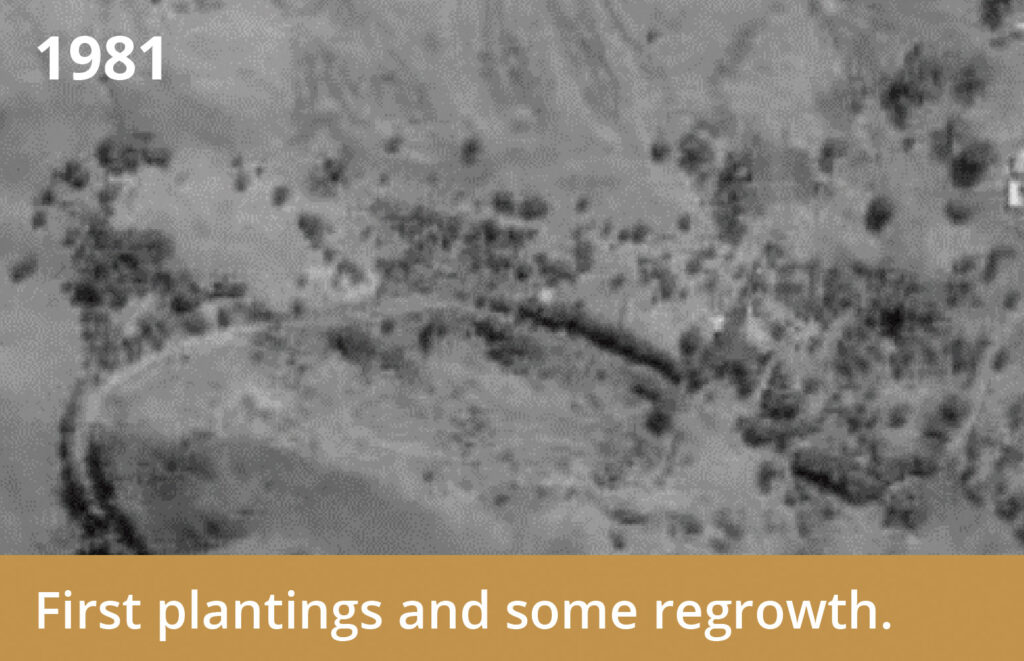
When we bought the property, we wanted to plant a forest. By doing so, we hoped to rehabilitate this eroded and slip-prone land. The grassland areas had a thick matting of kikiyu. Steep slopes and rocky patches were a mixture of Molasses and Blady Grass. Fencelines were a thicket of Broad-leaf Privet, while gullies were an impenetrable thicket of lantana, Wild Tobacco, Easter Cassia and Cockspur. This growth had become rampant in the early 1970s when there had been numerous owners and no-one in residence.
A neighbour had agisted his cows on the block during those years and we continued this arrangement for some time.
Did we have a clear plan? Did we know how and where to begin? No, not really. I wish I knew then what I now know.
What we had was a few ideas and some skills and experience in propagating plants from seed and cuttings. We had a strong desire to repair the damage and to create a forest where, in living memory, one had existed. This idea was strengthened in 1976 by a visit to our place made by the 90 year old brother of my paternal grandfather. He told me of how, 70 years earlier, he had worked for Joe McCarthy, and using only an axe, a springboard and practical know-how, he and others cleared scrub in the Maleny district for the sum of 30 shillings an acre.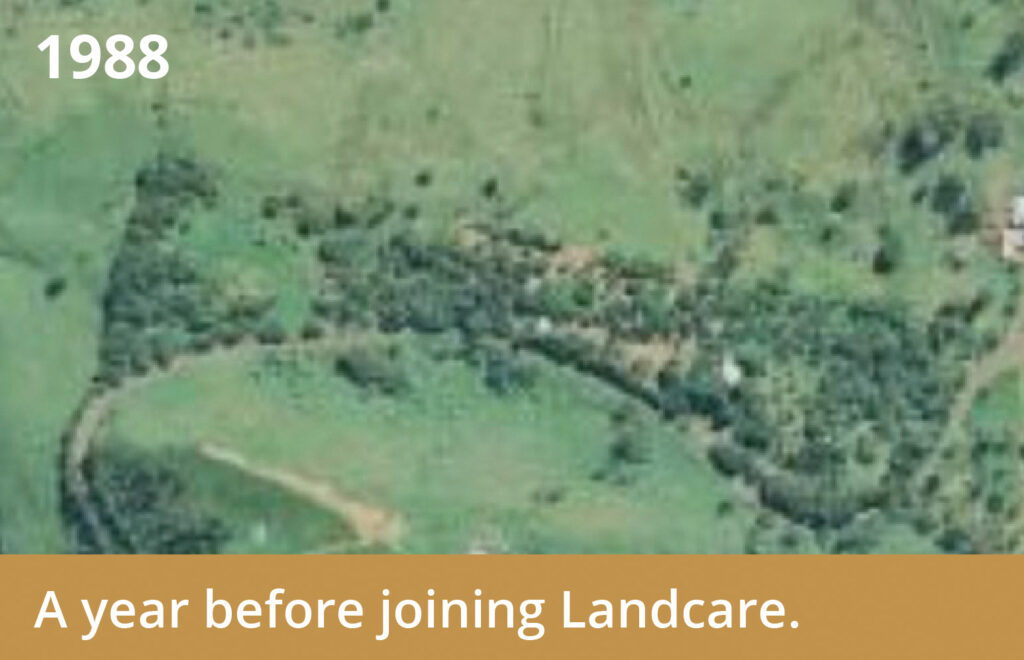
So where to begin? The first plantings were near the significant land slip. My aim was to repair this damage. Over the next 45 years, we did so, but not in an orderly, predictable manner. We actually established upwards of a dozen smaller, discrete plantings. Their size and location were determined by a number of factors including topography, the ability to exclude cattle, time required to prep and plant a given site, plus our increasing knowledge of what and how to do things.
We initially planted trees in a grid, six metres apart, believing they would require this much space to grow with health and vigour. This is approx 250 trees per hectare. In time, we came to appreciate the desirability of establishing edge closure and a canopy as soon as possible. This required pioneer species to be planted at a density of 1,000 per hectare, plus the planting of understorey species at a similar density. As the canopy became established, many original rainforest species have naturally regenerated.
Would we go about things the same way today? No. We were vaguely aware of the presence of a few endemic species that had managed to regenerate along gullies and fencelines, such as Red Cedar, Red Bean, Sandpaper Fig and Tamarind. We were quite unaware of native grasses, ferns and vines, and in our ignorance, we failed to nurture their growth.
Were we to begin our project today, we would seek out and treasure any such natural regeneration, considering each a gem. They would be our starting point, and their survival and growth would be our primary focus.
Our first major planting was in 1976. It was late spring, early summer. The weather was hot and dry. Cattle had reduced the grass to stubble. We arranged for a local farmer to build some internal fencing to exclude cattle from the planting area. The ground was bare and compacted.
My wife and I prepared each planting site using only hand tools, namely, a pick, crowbar and a spade. The thick latticewok roots of kikiyu were difficult to cut through. It was slow, hot work. However, time was on our side. We would not start planting before the wet season arrived.
In the meantime, we turned our attention to what to plant. Our first thought was to contact the Qld Department of Forestry. An officer visited our place and advised that the soil and location would be suitable for the growing of Hoop Pine. However, a monoculture plantation was not quite what we had in mind. We next visited a number of plant nurseries. Only one or two stocked any rainforest species, and even then, the range was limited and expensive. We made our purchases and planted – only to realise years later that most were endemic to other regions, in particular, North Queensland. For this first planting, we transplanted a few dozen Tallowwood seedlings from the home of my maternal grandparents in Palmwoods. Today, these Eucalyptus microcorys are graceful giants in excess of 80cm diameter.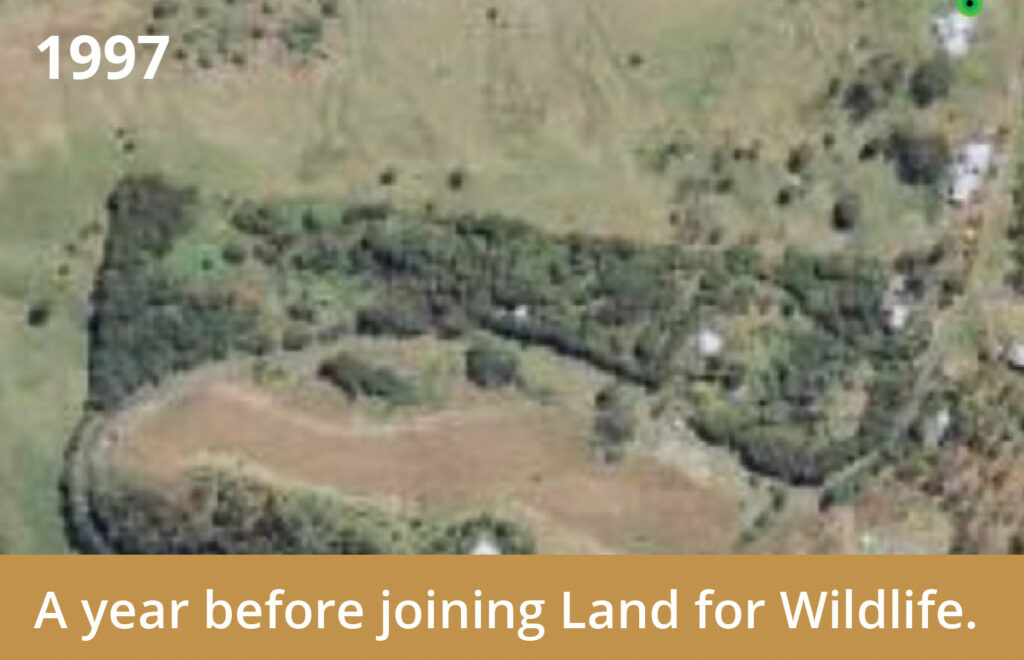
Our losses from this first planting were few and it is amazing that so many survived given our inexperience and the difficult conditions. Four months after our first planting, the seedlings were lost under a blanket of metre-high kikiyu grass and we had to find our young trees.
Henceforth we purchased bundles of ‘tomato stakes‘ from a local timber mill, and used one to mark each planting site. Later, we standardised this process by always placing the stake on the southern side of the young tree. By this means we tried to minimise accidental damage by whipper-snipper, and the stakes helped me locate the plant when I was hand-weeding. A later refinement was to place two stakes – one north, one south.
The planting of a tree – the digging of a hole, placing the tree in the ground, watering it in – this is the work of minutes. The short, easy part of the process when compared with the years of effort of caring for it, of nurturing its survival and growth. We found that hand-weeding needed to be done 6-8 times a year for the first few years after planting. With each successive planting, the weed maintenance workload increased. Given that weekends and holidays were the only time available to us to do this work, we had to limit new plantings to about 150 trees each year. This became the pattern of our land stewardship for the next 15 years.
We experimented with a number of different strategies to minimise our losses and learnt a few things not to do, namely:
- Placing rotting vegetation at the bottom of every hole as a way of increasing the level of soil organic matter seemed to attract bandicoots and echidnas. They uprooted many of our plantings, presumably to get the insects.
- We placed layers of newspaper or cardboard around young trees to suppress weed growth, but when it dried out, it was easily torn, blown away by wind or displaced by wildlife.
- We spread out rolls of weed matting and planted through this material. It reduced the growth of grass and weeds, but it also inhibited germination of native plants through natural regeneration.
We also learnt a few good lessons such as:
- Greatly reducing the spacing between planted trees accelerates the development of a canopy.
- Placing a halo of mulch around each plant is an effective way of keeping in soil moisture and reducing weed growth.
- Using a wheelie bin to cart water to our trees made the job of watering in seedlings a bit easier. Once in the ground, our plantings were wholly reliant upon rainfall for their survival.
- Autumn is the best time of year to plant when daytime temperatures are falling and soil moisture levels are high.
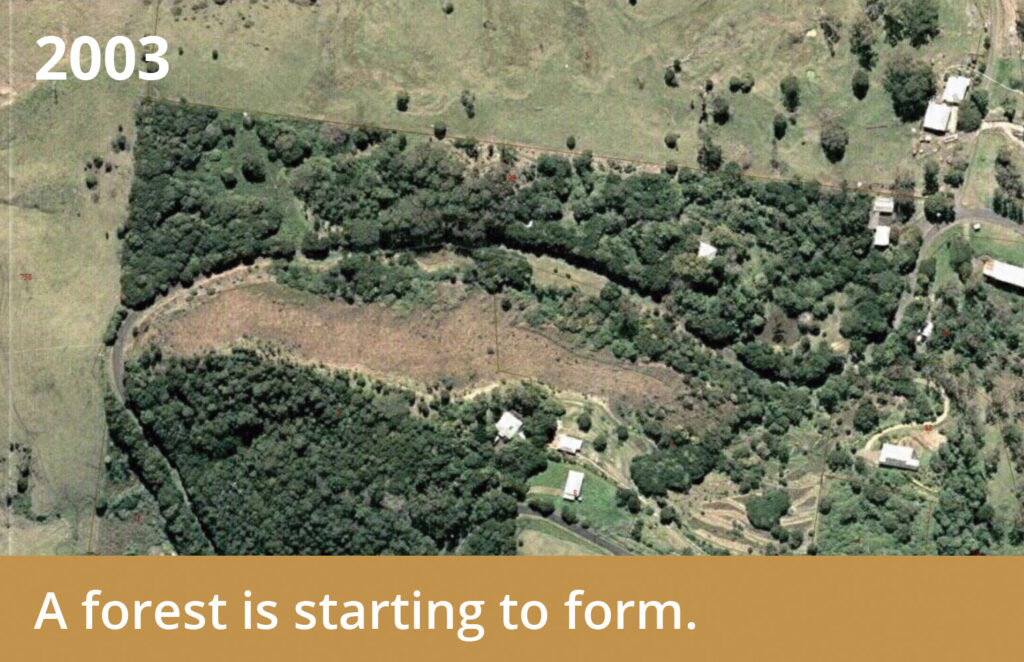
In the 1980s, we began hiring contractors to slash the weeds around our plantings. However, I continued to do all hand-weeding and site preparation. From memory, 2002 was the first year we paid contractors to help with planting. Innovations were many and transformative. They included pre-prep spraying of a designated planting area, the use of a mechanical post-hole digger and effective herbicide control of lantana and privet. We were now planting hundreds of trees at a time rather than dozens!
To this day, I continue to do all close hand-weeding of young trees, using a few simple tools that include secateurs, a pruning saw, and a long-handled screw-driver. I refer to it as “my hand-held crowbar”. It makes me very proficient in the removal of deep-rooted vines, privet seedlings, lantana and a host of other woody weeds. I am unable to use power tools such as a motor mower, brush-cutter or chain saw, or to use chemical sprays. It is probably a good time to say that I am blind.
I rely on other senses, especially smell and touch, and refer to my fingers as “my eyes”. Avoiding injury from thorny weeds and jumper ants can be challenging. For me, wearing gloves is a bit like being blindfolded. I also rely on my wife to inform me and prioritise what needs to be done, such as removal of windfalls or weeds that are smothering young plants.
Closer settlement came to the area in the mid-1980s after the sub-division of the adjacent dairy farm. Fortunately, one new neighbour, then a second, began planting trees on their block. In conjunction with our project, this is helping to establish a green corridor on this section of the Mooloola River headwaters. Connectivity is essential in the re-creation of habitat in which wildlife can flourish.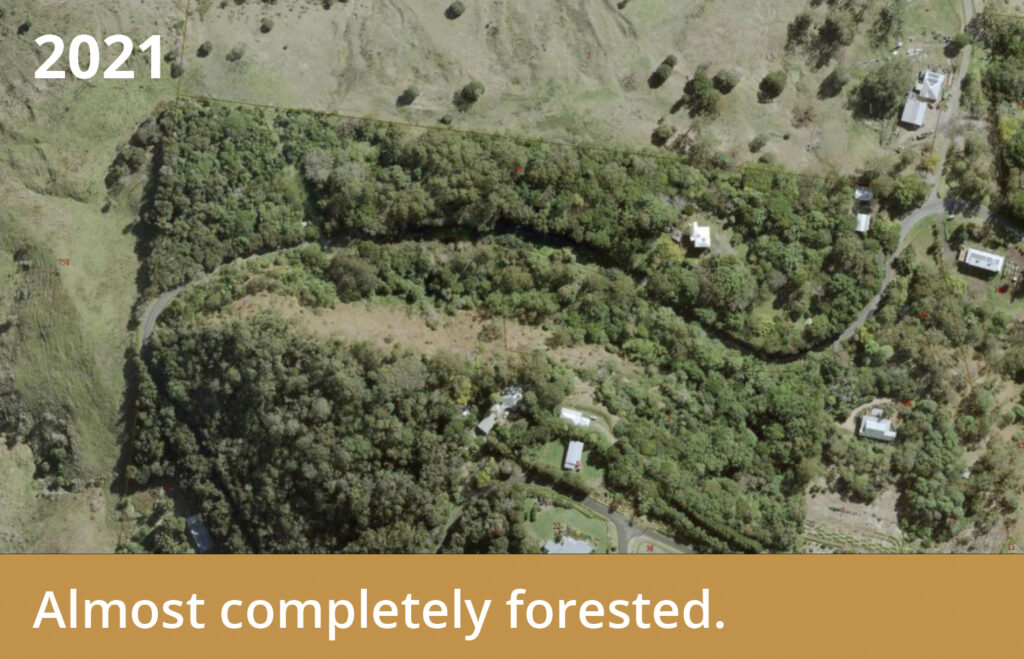
Today, there are a number of schemes and publications which promote the kind of work we have been doing. A remarkable program in this regard is Land for Wildlife, which we joined in 1998. We have learned much through attending LfW field trips, workshops and forums, and through meeting like-minded landowners. We have received invaluable advice and guidance from Conservation Partnership Officers on visits they have made to our property. On a number of occasions, we have also received financial assistance from Sunshine Coast Council through their Landholder Environment Grants, which have enabled us to accelerate our rate of planting and to link discrete plantings.
Barung Landcare is both a pioneer and a leader in the promotion of environmental awareness and action. Its nursery raises thousands of endemic plants and has become a major source of supply for us.
In 2011 we contacted the Queensland Government about establishing a conservation covenant. Two officers from Gympie made a visit and we were duly informed that our property did not satisfy the eligibility criteria as it did not contain remnant vegetation mapped as a Regional Ecosystem. In 2020, after a year-long process, we did achieve our goal, and we now have a conservation covenant with Sunshine Coast Council covering approx 60% of our property. This is registered on title and will be in place for future owners.
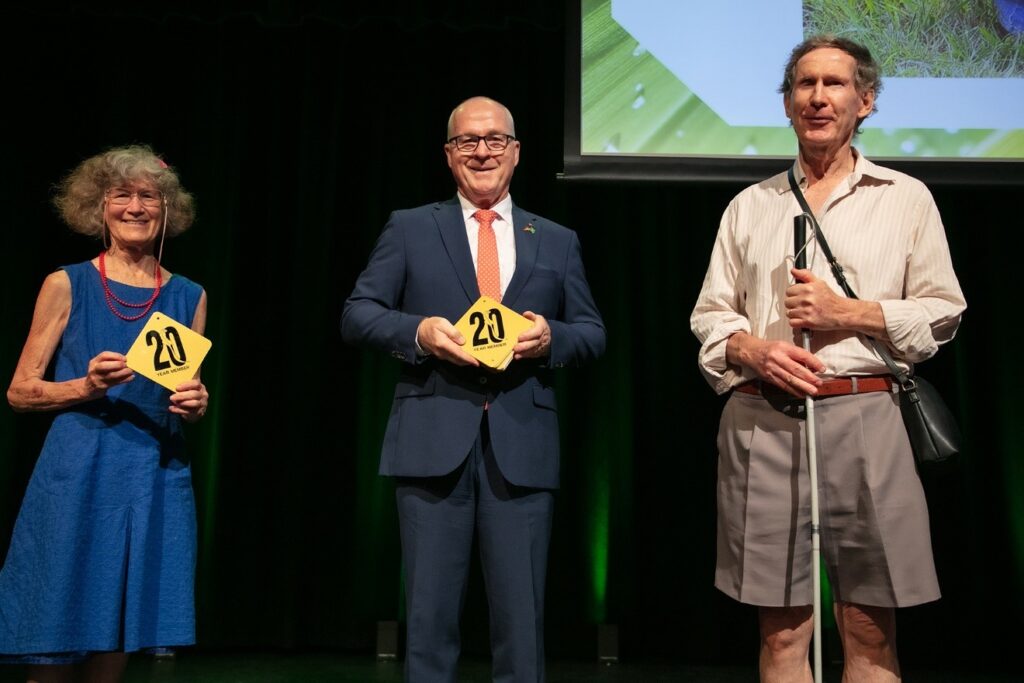 As a friend of mine has often remarked, “There’s a hard way and an easy way to do most things”. You would have to agree that we tried a few hard ways to do the things we’ve done. I have had no sight for over 50 years, and for 40 of those years was employed full-time as a qualified social worker. However, working on my property has been a pleasure, a labour of love, and an ‘occupational therapy’ that sustained me personally, and enabled me to have a demanding professional career.
As a friend of mine has often remarked, “There’s a hard way and an easy way to do most things”. You would have to agree that we tried a few hard ways to do the things we’ve done. I have had no sight for over 50 years, and for 40 of those years was employed full-time as a qualified social worker. However, working on my property has been a pleasure, a labour of love, and an ‘occupational therapy’ that sustained me personally, and enabled me to have a demanding professional career.
Article by Terry Boyle
Land for Wildlife member
Bald Knob, Sunshine Coast
